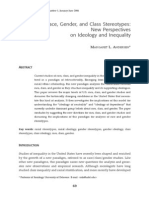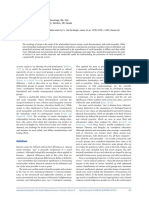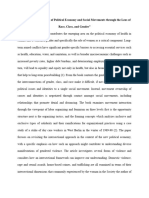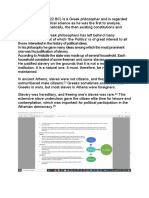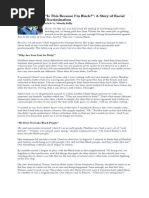0 ratings0% found this document useful (0 votes)
4 viewsWho's Black and Why?: Summary of Anthropological Article On Racism
Who's Black and Why?: Summary of Anthropological Article On Racism
Uploaded by
komalpharal2022Copyright:
© All Rights Reserved
Available Formats
Download as DOCX, PDF, TXT or read online from Scribd
Who's Black and Why?: Summary of Anthropological Article On Racism
Who's Black and Why?: Summary of Anthropological Article On Racism
Uploaded by
komalpharal20220 ratings0% found this document useful (0 votes)
4 views3 pagesOriginal Title
ac52efae-8dc9-439e-b749-193ceda21744
Copyright
© © All Rights Reserved
Available Formats
DOCX, PDF, TXT or read online from Scribd
Share this document
Did you find this document useful?
Is this content inappropriate?
Copyright:
© All Rights Reserved
Available Formats
Download as DOCX, PDF, TXT or read online from Scribd
Download as docx, pdf, or txt
0 ratings0% found this document useful (0 votes)
4 views3 pagesWho's Black and Why?: Summary of Anthropological Article On Racism
Who's Black and Why?: Summary of Anthropological Article On Racism
Uploaded by
komalpharal2022Copyright:
© All Rights Reserved
Available Formats
Download as DOCX, PDF, TXT or read online from Scribd
Download as docx, pdf, or txt
You are on page 1of 3
**Summary of Anthropological Article on
Racism**
Who's Black and Why?
Title: "Exploring Contemporary racism in [Country of Origin]: A
Sociocultural Perspective"
This article examines the basic aspects of racism in [Country of
Origin]. The study show us that how racism effect our daily life, social
institutions, and cultural . This practices based on ethnographic
research done in both urban and rural areas.
The research's finding is that historical racism still present and it
continually influence attitudes ,actions and behavior of people . The
sayings of the participants that how particular caste and ethnic groups
are oppressed and present and how nationalist tactic’s are used to
create violence . The study also highlights how racism interacts with
other forms of violence and class violence and how people have to cope
with these situations with their true identities.
The essay also shows how institutional racism contributes to the
continuation in opportunity and resource availability. Racialize social
and economic stratification is placed by discriminatory laws and
practices in the healthcare, job, and education sectors. Furthermore,
cultural racism is explored, power and how popular culture and media
marginalized racial groups and reinforce preconceptions against
them.
The study also show that how racism is changing in light of
globalization and
cross-border migration. Islam and xenophobic sentiments towards
groups are recognizes as modern-day examples of racism by cultural
and financial fears.
The essay offers a thorough examination of racism overall, stressing its
complexity and interactions with historical, social and economic, and
cultural elements.
**Contributions to Anthropological Debates about Race**
This article offers a comprehensive understanding of racism within the
particular context of [Country of Origin], which shows contributes to
particular discussions regarding race.
Through the use of a social culture . the study looks at how racism is
ingrained in social norms and cultural practices, going by personal
damages.
The article's emphasis on the sociality of racism—that is, how race
interacts with other axes of oppression to influence people's
experiences of privilege —is one of its most important contributions.
This inter sectional approach shows the questions ideas about race
and highlights how important it is to consider various aspects of
identity when examining power and dominance structures.
The paper also advances the conversation on structural racism by
exposing the ways that racial hierarchies in [Country of Origin] are
sustained by systematic injustices and historical legacies. The research
makes the case for structural interventions to address systemic
inequalities and advance equity and inclusion by illuminating the
manner in which racism functions at institutional levels.
Furthermore, by demonstrating how media portrayals and cultural
discourses perpetuate racial stereotypes and prejudices, the paper
broadens the definition of racism to encompass cultural components.
Through examining the function of cultural racism, the study
emphasizes how critical it is to oppose prevailing narratives and offer
substitutes that refute racial stereotypes.
In general, this essay advances anthropological understandings of race
by supporting interdisciplinary approaches to combat systematic
inequalities and providing empirical insights into the intricacies of
racism in [Country of Origin].
Referenc
es Ciucci, C. (2022). Who’s Black , (2),
and Why? 69.
You might also like
- Gayle, Addison-The Black Aesthetic.-Doubleday (1971)Document461 pagesGayle, Addison-The Black Aesthetic.-Doubleday (1971)lucicruz100% (8)
- Dill and Zambrana Emerging IntersectionsDocument22 pagesDill and Zambrana Emerging IntersectionsBobby0% (1)
- Understanding Racism and The Role of Identity Politics in Anti-Racism Movements in AmericaDocument5 pagesUnderstanding Racism and The Role of Identity Politics in Anti-Racism Movements in AmericaInternational Journal of Innovative Science and Research TechnologyNo ratings yet
- M2 - Antiracist-Frame-CSSPDocument2 pagesM2 - Antiracist-Frame-CSSPdyamon02No ratings yet
- Yee. J. (2005) Critical Anti-Rasism PraxisDocument18 pagesYee. J. (2005) Critical Anti-Rasism PraxisLaura KassymNo ratings yet
- 1000 Word Essay About DiscriminationDocument3 pages1000 Word Essay About DiscriminationJean RomeroNo ratings yet
- Socio Caste and ClasssDocument24 pagesSocio Caste and Classsshubhamnv057No ratings yet
- Gultural Competency As New Racism - An Ontology of ForettingDocument13 pagesGultural Competency As New Racism - An Ontology of Forettingrosayooyeon.jungNo ratings yet
- 2008 Racisms Conference ProceedingsDocument172 pages2008 Racisms Conference ProceedingsWaqar AhmadNo ratings yet
- Racism PresentationDocument9 pagesRacism PresentationafreenNo ratings yet
- Reading Journal Template - Prompt. (1) .EditedDocument3 pagesReading Journal Template - Prompt. (1) .Editedpmn5658No ratings yet
- WHAT IS GENDER STUDIESDocument2 pagesWHAT IS GENDER STUDIESabbassNo ratings yet
- Hunter Racial Epistem On Soc Sci MethodsDocument20 pagesHunter Racial Epistem On Soc Sci MethodsBlythe TomNo ratings yet
- RaceDocument3 pagesRaceZeeshan NasirNo ratings yet
- GENDERDocument9 pagesGENDERchemjorsofiaNo ratings yet
- Cultural Studies, Multiculturalism, and Media Culture by Douglas Kellner (Paper)Document22 pagesCultural Studies, Multiculturalism, and Media Culture by Douglas Kellner (Paper)Nawang WulanNo ratings yet
- 02 Harrison 2Document22 pages02 Harrison 2kipedizisaiNo ratings yet
- 2021 - Burkette Warhol - Crossing Borders Making ConnectionsDocument17 pages2021 - Burkette Warhol - Crossing Borders Making Connectionsviviperez084No ratings yet
- Breaking the Chains of Prejudice: Understanding Racism's MindsetFrom EverandBreaking the Chains of Prejudice: Understanding Racism's MindsetNo ratings yet
- Importance of Racial InjusticeDocument7 pagesImportance of Racial InjusticeJosphatNo ratings yet
- Cultural Studies, Multiculturalism, and Media CultureDocument18 pagesCultural Studies, Multiculturalism, and Media Culturekatnia100% (2)
- Intersectionality in Sex Therapy: Opportunities For Promoting Sexual Wellness Among Queer People of ColorDocument7 pagesIntersectionality in Sex Therapy: Opportunities For Promoting Sexual Wellness Among Queer People of ColorManuela PeixotoNo ratings yet
- Racism Thesis TopicsDocument4 pagesRacism Thesis Topicsafjrydnwp100% (2)
- Anthropology AssigmentDocument16 pagesAnthropology AssigmentMma CooraaNo ratings yet
- Ethnicity and AnthropologyDocument8 pagesEthnicity and Anthropologyrobertlukas024No ratings yet
- Sociology of RacismDocument14 pagesSociology of RacismMelodyNo ratings yet
- Understanding Race (4) (2) (1) - 1 - 7Document11 pagesUnderstanding Race (4) (2) (1) - 1 - 7mohitasurya03No ratings yet
- Dill and Zambrana Emerging IntersectionsDocument22 pagesDill and Zambrana Emerging IntersectionsiamnotsupermanhahahaNo ratings yet
- Race and Ethnicity.Document29 pagesRace and Ethnicity.mia100% (2)
- Arvin DecolonizingFeminismChallenging 2013Document28 pagesArvin DecolonizingFeminismChallenging 2013MarianaNo ratings yet
- Racial Conceptualization2009Document27 pagesRacial Conceptualization2009Yoame ErNo ratings yet
- UrbanizationDocument1 pageUrbanizationallen legaspiNo ratings yet
- Neoliberal Policy & The School-to-Prison PipelineDocument14 pagesNeoliberal Policy & The School-to-Prison PipelineDriving WheelNo ratings yet
- Carlos Augusto Sant'Anna Guimarães: Racism As A Form of Politics: Brazilian Racial PoliticsDocument30 pagesCarlos Augusto Sant'Anna Guimarães: Racism As A Form of Politics: Brazilian Racial PoliticsLucas DillNo ratings yet
- POL609 EssayDocument9 pagesPOL609 EssaySukhmani GrewalNo ratings yet
- ASC233-Hollinsworth David-Race and Racism in Australia-Racism Concepts Theories and Approaches-Pp40-51Document13 pagesASC233-Hollinsworth David-Race and Racism in Australia-Racism Concepts Theories and Approaches-Pp40-51PNo ratings yet
- Race, Gender, and Class Stereotypes: New Perspectives On Ideology and InequalityDocument23 pagesRace, Gender, and Class Stereotypes: New Perspectives On Ideology and InequalitypilinpezNo ratings yet
- Ethnic and Racial Diversity in Society - EditedDocument9 pagesEthnic and Racial Diversity in Society - Editedkandieerastus70No ratings yet
- KNOWLES Caroline Theorizing Race and Ethnicity Contemporary Paradigms and PerspectivesDocument20 pagesKNOWLES Caroline Theorizing Race and Ethnicity Contemporary Paradigms and PerspectivesJonathan FerreiraNo ratings yet
- What Is IntersectionalityDocument6 pagesWhat Is IntersectionalityLewmas UyimisNo ratings yet
- Indigenous Peoples in The Capitalist World System - Researching KDocument41 pagesIndigenous Peoples in The Capitalist World System - Researching KAlice WalkerNo ratings yet
- IntersectionalityDocument53 pagesIntersectionalityRodriguez100% (1)
- Bashi TreitlerDocument15 pagesBashi TreitlerBlythe TomNo ratings yet
- Clair Denis 2015 PDFDocument7 pagesClair Denis 2015 PDFGiuseppe NapoliNo ratings yet
- SynthesisDocument8 pagesSynthesisCALIWA, MAICA JEAN R.No ratings yet
- Definition of Systemic Racism in SociologyDocument3 pagesDefinition of Systemic Racism in Sociologyapi-533945853No ratings yet
- Thesis Statement On Race and EthnicityDocument7 pagesThesis Statement On Race and Ethnicityafkodkedr100% (2)
- RacismDocument24 pagesRacismroseerose.1002No ratings yet
- Law and Ethics PaperDocument8 pagesLaw and Ethics PaperBrandon LatimoreNo ratings yet
- Caste, Class and GenderDocument30 pagesCaste, Class and GenderVipulShukla83% (6)
- Race and EthnicityDocument1 pageRace and Ethnicityallen legaspiNo ratings yet
- Critical Race TheoryDocument3 pagesCritical Race TheoryMax TeixeiraNo ratings yet
- 24 Ethnicity As Cognition PDFDocument34 pages24 Ethnicity As Cognition PDFUtkuNo ratings yet
- Critical Race TheoryDocument3 pagesCritical Race TheoryElena Arvaniti100% (1)
- Managing The Diverse Organization: The Imperative For A New Multicultural ParadigmDocument25 pagesManaging The Diverse Organization: The Imperative For A New Multicultural Paradigmvzaya1975No ratings yet
- Institutional Racism and Segregated CommunitiesDocument14 pagesInstitutional Racism and Segregated CommunitiesFIUStudentNo ratings yet
- Wa0000.Document5 pagesWa0000.abdulazeez FatimaNo ratings yet
- Culture and Inequality Identity, Ideology, and Difference in Postascriptive SocietyDocument19 pagesCulture and Inequality Identity, Ideology, and Difference in Postascriptive SocietyAgastaya ThapaNo ratings yet
- Causes of Culture - National Differences in Cultural EmbeddednessDocument12 pagesCauses of Culture - National Differences in Cultural Embeddednesslinhtinhbeng2009No ratings yet
- Workbook & Summary - How To Be An Antiracist - Based On The Book By Ibram X. KendiFrom EverandWorkbook & Summary - How To Be An Antiracist - Based On The Book By Ibram X. KendiNo ratings yet
- EthnicityDocument4 pagesEthnicityMichelle BermeNo ratings yet
- Blacks Aren't HumanDocument1 pageBlacks Aren't HumanJ.J.No ratings yet
- Stamped Group FinalDocument2 pagesStamped Group Finalapi-542017219No ratings yet
- Popular Education As An Antiracist Approach: Pedagogical Experiences For A Decolonial LearningDocument35 pagesPopular Education As An Antiracist Approach: Pedagogical Experiences For A Decolonial LearningDiego EmilioNo ratings yet
- SlaveryDocument3 pagesSlaveryjiasd bvdseNo ratings yet
- Draft Uts GeneralizationDocument5 pagesDraft Uts GeneralizationJaein JangNo ratings yet
- Pypexhibition2016 17Document2 pagesPypexhibition2016 17api-356697645No ratings yet
- Smit Partiality JamesDocument11 pagesSmit Partiality Jamesptralejo100% (1)
- César Tort - The Fair Race's Darkest HourDocument645 pagesCésar Tort - The Fair Race's Darkest HourRoyer CastrillónNo ratings yet
- Nevada Sagebrush Archives 02/21/12Document18 pagesNevada Sagebrush Archives 02/21/12The Nevada SagebrushNo ratings yet
- Chapter 13 - Prejudice Causes & CuresDocument7 pagesChapter 13 - Prejudice Causes & CuresblabliblubbyNo ratings yet
- Catch Up FridayDocument3 pagesCatch Up FridaySheryl SalvadorNo ratings yet
- Rizal 13-14Document2 pagesRizal 13-14Jhon Mark Anillo Lamano INo ratings yet
- Siddique 3333Document271 pagesSiddique 3333Prachi BishtNo ratings yet
- 69315392-Black-Power-and-the-Garvey-Movement (1) (2013 - 03 - 19 00 - 04 - 23 UTC) PDFDocument308 pages69315392-Black-Power-and-the-Garvey-Movement (1) (2013 - 03 - 19 00 - 04 - 23 UTC) PDFDerrick Trueblood Tolliver100% (1)
- Language Ideologies: A SyllabusDocument10 pagesLanguage Ideologies: A SyllabusdamnthemanateeNo ratings yet
- Kristin White and Ina Klingenberg - Migration and Intercultural Psychoanalysis - Unconscious Forces and Clinical Issues-Routledge (2021)Document161 pagesKristin White and Ina Klingenberg - Migration and Intercultural Psychoanalysis - Unconscious Forces and Clinical Issues-Routledge (2021)Claudio Dennis ArriojasNo ratings yet
- Fritz Oser ChangingDevilsintoAngelsDocument13 pagesFritz Oser ChangingDevilsintoAngelsEdijane CostaNo ratings yet
- A Post Colonial Critical History of Heart of DarknessDocument7 pagesA Post Colonial Critical History of Heart of DarknessGuido JablonowskyNo ratings yet
- English Literature ProjectDocument6 pagesEnglish Literature Projectjhaashish08.06.07No ratings yet
- Ethnic ConflictDocument10 pagesEthnic ConflictJadid HoqueNo ratings yet
- California State University, Monterey Bay: An Agenda To Strengthen Culturally Responsive PedagogyDocument17 pagesCalifornia State University, Monterey Bay: An Agenda To Strengthen Culturally Responsive PedagogyAnilGNo ratings yet
- 510 261 HanebrinkDocument4 pages510 261 HanebrinkThais SR PandaNo ratings yet
- Race, Racism, and Representation: Philippine Pop CultureDocument22 pagesRace, Racism, and Representation: Philippine Pop CultureShayne PaduaNo ratings yet
- An Open Letter To Non-Black POCs PDFDocument2 pagesAn Open Letter To Non-Black POCs PDFannie3662100% (5)
- Quiz Prep - LitwackDocument6 pagesQuiz Prep - Litwackanon_471802813No ratings yet
- G.R. No. 128845Document7 pagesG.R. No. 128845Amicus CuriaeNo ratings yet
- King Kong Race, Sex, and Rebellion: by David N. RosenDocument5 pagesKing Kong Race, Sex, and Rebellion: by David N. RosenBode OdetNo ratings yet
- Opening The Conversation: Studying Intercultural CommunicationDocument29 pagesOpening The Conversation: Studying Intercultural CommunicationDoctora ArjNo ratings yet




































